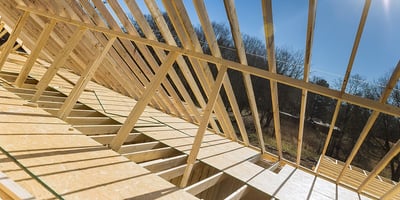As environmentally friendly building methods continue to rise in popularity, so too does timber construction—and that’s because there are few building materials out there that are better for the environment.
With that, timber lends itself well to tools and building practices that are also environmentally friendly. Consider the patented LignoLoc® Wooden Nail System from BECK, for example. These are environmentally friendly, pneumatically driven, wooden fasteners designed to be used in timber construction. Using them, you can create 100% wooden cross-laminated timber panels that are not only green and sustainable, but also thermally sound enough to reduce energy usage in the finished building.
That’s the true beauty of wood. There are multiple ways in which it helps the environment—and we’re going to examine some of these benefits here.
Wood and the Carbon Question
Carbon, when it forms carbon dioxide, is a major pollutant—and that’s one of the biggest reasons why the building industry is turning toward more environmentally friendly options. Steel and concrete production both produce massive amounts of greenhouse gas emissions whereas lumber production produces fewer emissions.
On top of that, steel and concrete are made up of elements other than carbon. Trees, on the other hand, are approximately 50% carbon, which makes them an important way to pull it out of the ecosystem and successfully sequester carbon.
Timber is Nontoxic
Many building materials are prone to off-gassing, which is a process in which the material produces toxic gases over time. In fact, some wood products are among the worst offenders for off-gassing—particularly plywood, particleboard, and other products that are loaded with glues and other compounds that produce toxic gases.
Conversely, wood construction that doesn’t feature a lot of glues or other inorganic compounds is one of the better choices to reduce toxic emissions. That’s one reason why cross-laminated timber and fasteners like LignoLoc® are growing in demand. Unlike particleboard or manufactured wood, with LignoLoc® and timber, you can create solid wood building components—without the toxic compounds.
Timber and Energy Usage
We mentioned earlier that timber production doesn’t produce as much carbon dioxide as steel or concrete—and that’s because it doesn’t take as much energy to produce timber as it does to produce steel or concrete.
And it’s not just the production phases that save on energy, either. Timber is an easy material to work with, which means it consumes less energy during the building process. If you’re working with prefabricated cross-laminated timber components, or mass timber construction builds, that energy usage goes down even further since these components can all be produced in an energy-optimized factory setting.
Once completed, a building that features mass timber construction can reduce energy usage quite a lot because wood is a natural insulator that works quite well to prevent thermal transfer. In one study, mass timber buildings constructed out of cross-laminated panels used between 17% and 35% less energy for heating and cooling.
Using LignoLoc® to Maximize Environmental Friendliness
Now that you understand the beauty of wood where the environment is concerned, it’s easy to see the advantages of BECK’s LignoLoc® Wooden Nail System. LignoLoc® wooden nails production has a CO² footprint that is 70% lower when compared with conventional steel fasteners since there is much less energy needed to obtain the raw material. On top of that, they won’t off-gas pollutants in a finished build.
All of this makes the LignoLoc® Wooden Nail System an incredible asset when it comes to sustainable building. You can create metal-free, chemical-free cross-laminated timber panels that perform beautifully in all weather conditions to help reduce heating and cooling costs.
Want to learn more about the LignoLoc® Wooden Nail System, or see it in action? Click below for a quick, informative video!
.svg.png)


